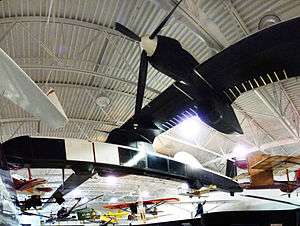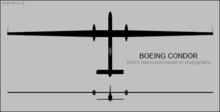Boeing Condor
The Boeing Condor is a high-tech test bed aerial reconnaissance unmanned aerial vehicle. It has a wingspan of over 200 feet.[1]
| Condor | |
|---|---|
 | |
| Condor on display at the Hiller Aviation Museum | |
| Role | Research UAV |
| National origin | United States |
| Manufacturer | Boeing |
| First flight | 9 October 1988 |
| Number built | 2 |
Carbon-fibre composite materials make up the bulk of the Condor's fuselage and wings. Although the Condor has a relatively low radar cross-section and infrared signature, it is not unobservable making it too vulnerable for use in military operations.[2]
The Condor is completely robotic, with an onboard computer to communicate with the computers on the ground via satellite to control all facets of the Condor's missions. The Condor's frame is made of mainly Carbon-fiber-reinforced polymer composite, as it gives off very low radar and heat signatures.[2]
In 1989, the Condor set the world piston-powered aircraft altitude record of 67,028 ft (20,430 m) and was the first aircraft to fly a fully automated flight from takeoff to landing and also setting an unofficial endurance world record in 1988 by flying continuously for more than 50 hours; the flight was not ratified by the Fédération Aéronautique Internationale (FAI) and is therefore not considered an official record.[3]
During its evaluations, the Condor logged over 300 flight hours, flying over Moses Lake, Washington.
Survivors
The first flight article is now on display in the Hiller Aviation Museum in San Carlos, California and the second is disassembled at the USAF Museum's restoration centre in Dayton OH.[1]
Specifications

Data from [4]
General characteristics
- Capacity: 2,500 lb (1,100 kg)
- Length: 66 ft (20 m)
- Wingspan: 205 ft (62 m)
- Gross weight: 21,000 lb (9,525 kg)
- Max takeoff weight: 21,000 lb (9,525 kg)
- Fuel capacity: 12000lb
- Powerplant: 2 × Continental TSOL-300-2 turbo-charged 6-cyl liquid-cooled horizontally-opposed piston engines, 175 hp (130 kW) each props driven thru a 2 speed gear box changed gears at 42000ft
- Propellers: 3 16' diameter-bladed composite propellers
Performance
- Maximum speed: 140 kn (160 mph, 260 km/h)
- Endurance: 161 hours +
- Service ceiling: 70,000 ft (20,500 m)
- Rate of climb: 2,010 ft/min (10.2 m/s)
- Lift-to-drag: 40:1 in cruising flight
References
- "Boeing Condor". hiller.org. Archived from the original on 23 July 2015. Retrieved 23 July 2015.
- "CONDOR UNMANNED AERIAL VEHICLE". boeing.com. Retrieved 23 July 2015.
- TRIMBLE, STEPHEN. Aurora seeks Orion production start after record flight "Aurora seeks Orion production start after record flight" Check
|url=value (help). flightglobal.com. WASHINGTON DC: Reed Business Information. Retrieved 23 July 2015. - "Boeing Condor". spyflight.co.uk. Archived from the original on 11 August 2015. Retrieved 23 July 2015.
External links
| Wikimedia Commons has media related to Boeing Condor. |
- Condor Unmanned Aerial Vehicle, Boeing
- The Condor, Hiller Aviation Museum
- Aviation Trivia